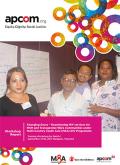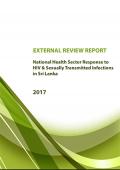What's New
Displaying results 1991 - 2000 of 4914

Resource | Infographics,
SRHR/HIV linkages are bidirectional synergies in policy, programmes, and service delivery that support comprehensive sexual and reproductive health needs and rights of all people, including people living with HIV, within a framework of gender equality and human rights.
These infographics highlight current guidance from WHO on key aspects of SRHR/HIV Linkages.

Resource | Publications,
Everywhere in the world, human rights violations, fear, prejudice, stigma and discrimination persist, including in health-care settings. Today, I am launching a UNAIDS report entitled Confronting discrimination, which describes the magnitude and impact of stigma and discrimination in health care and gives concrete examples for addressing it.

Resource | Publications,
The four days workshop in two batches was organized to reduce the impact of HIV among MSM and transgender population in South Asia. The workshop focus was to develop an understanding of all the relevant and emergent issues related to MSM and transgender population of South Asia region.
Partners In Progress, Consulting LLP, from India, was invited to conduct the workshop in two batches, the first batch from 12 -15 September and second batch from 18 to 21 September 2017, in Courtyard by Marriot hotel in Bangkok, Thailand. The workshop focused on addressing various relevant issues of HIV/AIDS programs amongst MSM/TG/HIJRA community in South Asia region.

Resource | Publications,
This report presents the key findings of the NFHS-4 survey in Chhattisgarh, followed by detailed tables and an appendix on sampling errors. At the time of finalization of this report, wealth quintiles for the country as a whole were not ready. Therefore, on finalization of the national report, the breakup of key indicators by wealth quintiles for all states will be provided as an additional document and uploaded on the official website of MoHFW and IIPS.

Resource | Publications,
Sri Lanka, during these last five years, has successfully maintained its low HIV prevalence status although numbers of HIV positive cases have been slowly rising over the years. The main population groups with a rising number of HIV positive cases have been males having sex with males (MSM) and returnee external migrant workers. However, numbers are not high so that identifying the key populations (KPs) in Sri Lanka is not straightforward.

Resource | Fact Sheets,
In September 2017, there were 936 new HIV antibody seropositive individuals reported to the HIV/AIDS and ART Registry of the Philippines (HARP). Eighty-six percent of those were asymptomatic at the time of reporting.

Resource | Publications,
This report presents the key findings of the NFHS-4 survey in Bihar, followed by detailed tables and an appendix on sampling errors. At the time of finalization of this report, wealth quintiles for the country as a whole were not ready. Therefore, on finalization of the national report, the breakup of key indicators by wealth quintiles for all states will be provided as an additional document and uploaded on the official website of MoHFW and IIPS.

Resource | Publications,
This report presents the key findings of the NFHS-4 survey in Madhya Pradesh, followed by detailed tables and an appendix on sampling errors. At the time of finalization of this report, wealth quintiles for the country as a whole were not ready. Therefore, on finalization of the national report, the breakup of key indicators by wealth quintiles for all states will be provided as an additional document and uploaded on the official website of MoHFW and IIPS.

Resource | Publications,
This report presents the key findings of the NFHS-4 survey in Uttar Pradesh, followed by detailed tables and an appendix on sampling errors. At the time of finalization of this report, the wealth quintiles for the country as a whole were not ready. Therefore, on finalization of the national report, tabulations of key indicators by wealth quintile for all states will be provided as an additional document and uploaded on the official website of MoHFW and IIPS.

Resource | Publications,
The 2016 SLDHS was conducted by the Department of Census and Statistics (DCS) for the Ministry of Health, Nutrition and Indigenous Medicine with assistance from the World Bank. It collected information for a series of demographic and health indicators at the national, urban and rural estate and district level to monitor progress and to support the identification and development of policies, programs and interventions. The 2016 SLDHS was successfully implemented in almost all households (99 percent) selected and for almost all ever married women (99 percent) identified in the household. Data was collected using Computer- Assisted Personal Interviewing technology (CAPI) for the first time in DCS.
It is also expected that this survey will serve as a continuation of the series of Demographic and Health Surveys conducted in Sri Lanka since 1987. This will also cater the needs of complication of a number of Sustainable Development Indicators.





